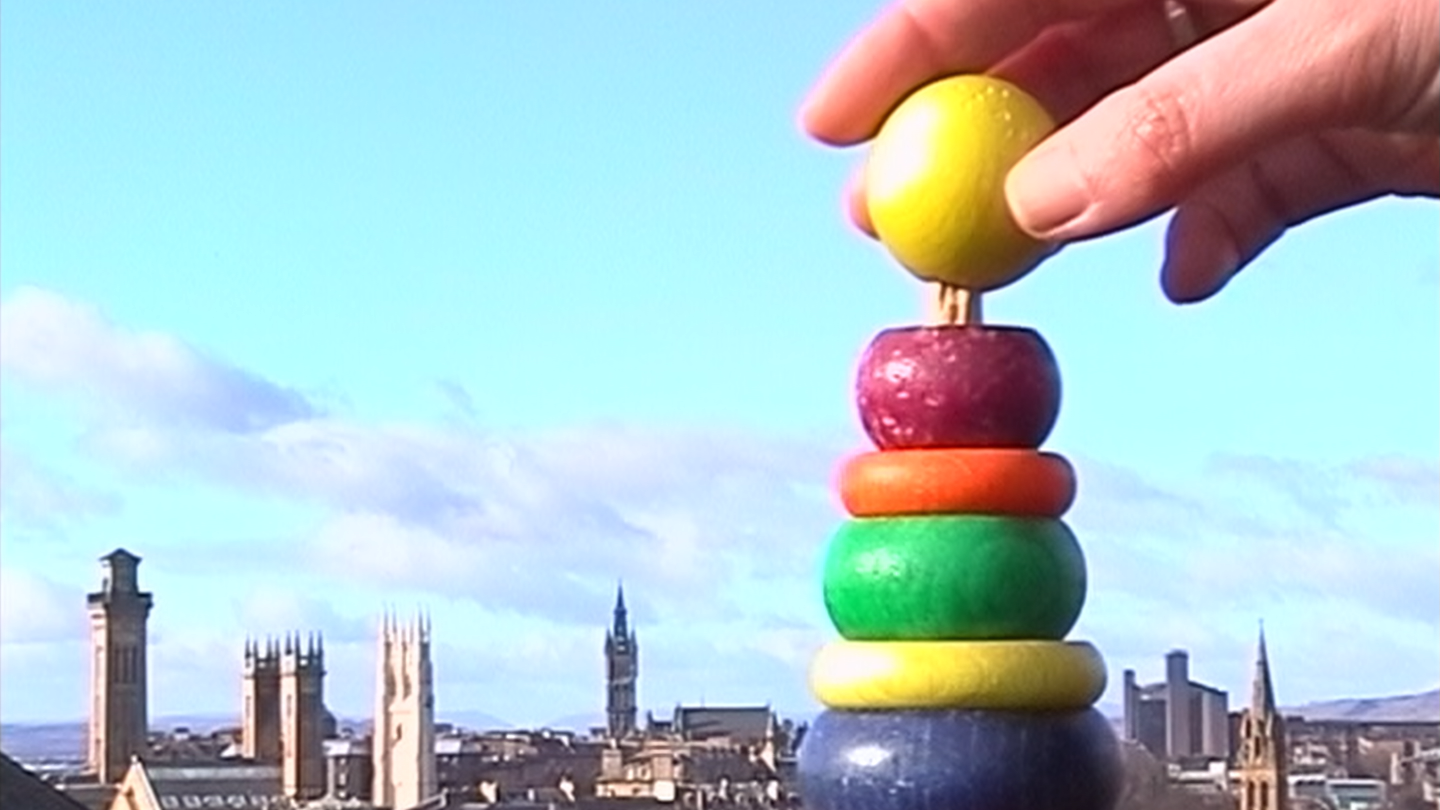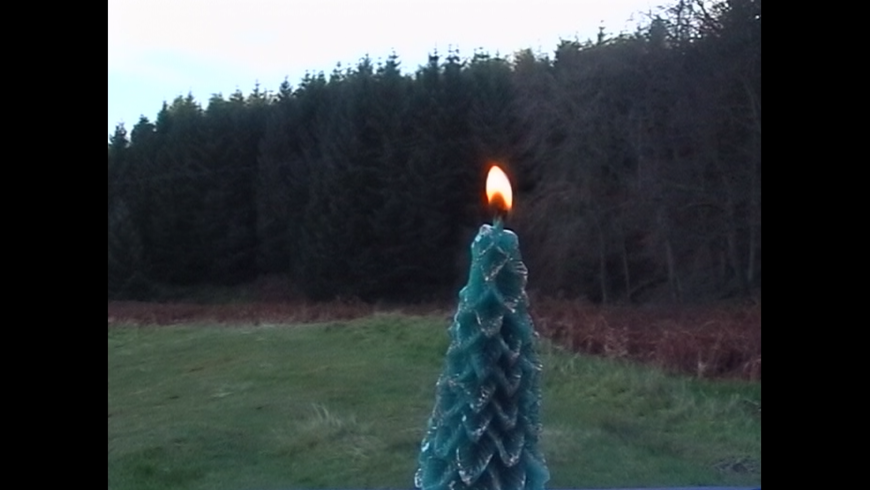Interludes: 20 Years Later
Mimi Howard
Writer and academic Mimi Howard considers Anne Bjerge Hansen’s Interludes against the ceaseless flow of video images in the present and the slower televisual rhythms of the past.
Projects
'Interludes' by Anne Bjerge Hansen is available now on FVU Watch.
Two decades ago, Danish-born, and then Glasgow-based, video artist Anne Bjerge Hansen cut segments from video footage shot between 1997 and 2003 and strung them together, popcorn pearls on a string, into a video series titled Interludes. The videos are bite-sized, varying in length from a few seconds to little more than a minute, and depict scenes both quotidian and confected. (In one, a sailboat moves gently across the water, backlit by the sun; in another, a ship in a bottle is pulled across the rocky ground by a cord.) This was a time, it feels too obvious and too necessary to say, before the attention-grabbing portals of TikTok, Instagram and Vine swallowed us all up. It was also before the founding of YouTube in 2005, when the platform’s most viral offerings were as unhinged and caustic as those by then-emergent video artists like Ryan Trecartin and Alex Bag. Ploughing its own furrow, Bjerge Hansen’s Interludes whittled out an atypically diaristic, unharried space between the Internet’s explosion of out-there, irony-coated videos and zany, turn-of-the millennium video art. The world’s pace, seen from its vantage point, slackened — got coated in a gracious slowness.
While holding the zeitgeisty themes of early-2000s video art at an arm’s length, Interludes nonetheless drew from the medium’s grab-bag of tactics. Evident throughout is an air of investigational, Bruce Nauman-like playfulness — the meeting of conceptual experimentation and school physics demonstration at a biting edge. Balloons, ropes, pulleys and mechanical whatsits populate its frame, sometimes manipulated by the artist and sometimes not, fixing our gaze upon the basic weirdness of the world’s silhouettes. While in other hands this attention to the ‘life of things’ might track with the basic contours of an early-2000s anti-consumerist project, a critique of commodity culture and its aesthetic absurdity, Bjerge Hansen is uninterested in pointedly turning our gaze to commodities per se. The focus is rather the negative space around them — the shadows they cast, the images they reflect. One clip, for example, highlights the famous Stomatol toothpaste sign in Stockholm, possibly the first lightbulb-lit animated advertisement of the early-twentieth century. The video begins with darkness, until it flickers to reveal the animation of toothpaste squeezed onto a toothbrush. The effect is a kind of neutralisation and deflation of advertisement to its most basic, composite parts: light and time.
Interludes equally shared in video art’s enduring, fundamental concern with interrogating television and the history of the moving image. The title is derived from the short clips that regularly punctuated early television schedules, especially those of the 1950s BBC, where videos of cats playing with toys, women throwing clay pots, or fish swimming in a tank were frequently to be seen between programmes or, as was more often the case, in the absence of programmes. Originally intended to simply to fill up space, or cover breaks in transmission, these interludes are also perhaps a recognition that something of real, humdrum existence needs to co-exist with amusement or entertainment for it to be effective. Bjerge Hansen seems to repeat but slightly displace the domestic intimacy of these original interlude videos with the help of a 1990s home-consumer video camera. While the lo-fi look was a common undercurrent of Noughties video art – intended to underscore its unintegrability into the crystalline, sleek advertisements of the mainstream – here it feels more like an invitation to tenderness. Public libraries, docks, ferries, restaurants, and parks become the object of the camera’s loving, familial gaze. The spirit of home videos is transplanted out onto the street.
In Annie Ernaux’s Exteriors, the writer sought to do something similar by recounting the daily happenings at her local supermarket, in the mall, and on her usual commuter train. ‘You can learn more about yourself by embracing the outside world,’ she argued, ‘than by taking refuge in the intimacy of a journal.’ Interludes too is an experiment in putting the passionate back into dispassionate observation: how can the inert culture of an epoch emote, in spite of itself? We are paradoxically presented with animated objects, roving landscapes, and sentient still lifes. Though unambiguously focused on the mundane, Bjerge Hansen’s visual vocabulary is leveraged in such a way that these ordinary things are made to look different, and seen anew. A stack of crocheted potholders, some of which bear the year of their making (1983, 1959, 1988) are peeled back to reveal the next with the camera staring down vertically, a view from which these items are never usually seen. From an equally estranging angle, in another clip, multiple hands clothed in garishly patterned gardening gloves are stacked upon one another, as in a school-yard game. Boats, dolphins, polka dots, textiles, confetti and other kitschy elements act as recurring motifs throughout. The material culture of the era is, to use the old literary term, defamiliarised.
Such objects are easily carbon-dated, lending the clips of Interludes a palpable, obvious historicity from our vantage point of 2023. But we might do well to avoid historicising, too. Unfolding an ongoing present shorn of identifying characteristics, Interludes tacitly argues against the subsumption of days into eras, moments into motifs—every instant becomes important: the languid, incessant thereness of our everyday is laid bare. Contained within this pearlescent vision of video as the accretion of life’s under-appreciated moments is, however, the impish promise of its inverse. Video now is the thing we watch in the meantime, between things — at all moments. The interlude is not recorded by video but fully appropriated by it, expanded like a balloon inflated within another, bigger balloon from its core to circumference, until the point of bursting. One need only look around the nearest train car to see the way video interjects into dead time from all angles, or makes the very idea of dead time patently impossible.
Interludes’ quiet doubling of life – the watching of ourselves, and other things, just being – shares, then, a kind of mutated core logic with our own age of video. Hitting ‘record’ makes our little lives somehow more important and more real. In one of her novels, the writer Rachel Kushner refers to the historical time of ignorance before misery as a ‘luminous winking bubble’. Bjerge Hansen’s work here was something more than prescient in its capture of an interlude on video before video became interlude. Nothing, after all, is co-opted by capital unless it is dangerous; video’s capacity to linger upon and retrieve the everyday, deposit it in recorded memory, is a power and a truth. Our own debauched and distracted era remains porous, perhaps, to recuperating this by reminding itself of the possibility for video’s slower, counteractive velocity. Each of Interludes’ sequences ends with the image of flashes of some kind: fireworks, lighters, sparklers. A bygone era does not flame out, but fizzes and flickers into the next, luminous and winking.
—
Mimi Howard is a writer and scholar based in New York and the winner of the Michael O'Pray Prize 2020.


